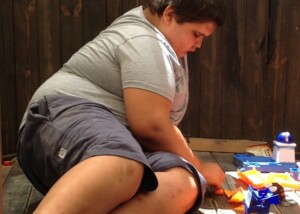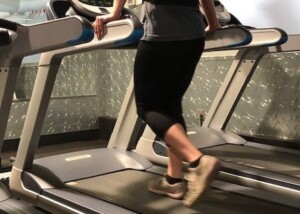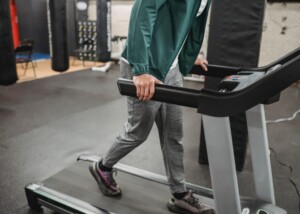Should Plus Size People Use Barbells or Machines?

If you’re obese or overweight and are wondering which is better, barbells or machines for fat loss, fitness and toning, I have the perfect answer for you. (more…)
What Sports Can Obese Kids Do Really Well?

An obese child does NOT need to sit on the sidelines while thinner kids participate in sports.
There are plenty of exciting sports that fat children can excel in or just plain gain loads of self-confidence. (more…)
Grueling Entire Body Workout: Uphill Tire Flipping

I’ll admit, I’ve never flipped a tire up a hill.
However, I’ve run up hills of all grades, and I’ve flipped a tire across a gymnasium.
Hefty Thighs Not Healthy: How to Lose Thigh Fat

“Fat acceptance” does not undo the fact that fat thighs are harmful to your health — as research now shows.
But you can get rid of the excess fat in your upper legs.
Get Rid of Harmful Fat Thighs
Does All the Walking Nurses Do Count As Aerobic Exercise?

Ever wonder if the tens of thousands of steps that a nurse walks every day should count as an aerobic workout, that she doesn’t need to train on a treadmill, take step classes or jog in the park? (more…)
If Age Slows Metabolism, Why Are Some Old Ladies So Thin?

Ever wonder why some elderly women are frightfully thin, when old age is supposed to slow metabolism and make fat gain easier?
Is there some magic reversal of this process?
If a woman has not been strength training, then by the time she’s 30, she begins losing muscle mass.
With that loss of muscle mass comes an increase in weight—in the form of fat.
This is why, as women (and men) get older, the general rule is that they gain weight.
It’s not that suddenly, at age 30, their appetite increases and keeps swelling as each birthday passes.
Rather, it’s the muscle loss that causes fat gain, because muscle is the body’s most metabolically active tissue, burning more calories per hour — just for sustenance — than any other tissue.
So if you lose muscle, your resting metabolism slows down…and you put on unwanted fat pounds.
Why are so many elderly women too thin?
If a woman never takes up strength training, she will lose about five pounds of muscle per decade beginning at around age 30.
She may still be able to fit into her size 8 wedding dress on her 60th birthday, but her body composition will be much different.
There will be a higher fat to muscle ratio, and she’ll look softer and flabbier though still a size 8.
But for most formerly size 8 or 6 women, they will now be a 10, 12 or even 14 or 16, by age 60—thanks to a stunted resting metabolic rate due to lost muscle mass.
So why do we see so many sickly-skinny elderly women?
They not only lack muscle mass, but where the devil is the fat that they were supposed to have gained since age 30?
“As we age, one thing that happens to our bodies is the loss of subcutaneous fat,” says Susan L. Besser, MD, with Mercy Medical Center, Baltimore; Diplomate, American Board of Obesity Medicine and board certified by the American Board of Family Medicine.
“Without that connective tissue the skin thins — tears more easily and wrinkles more — all giving a thinner appearance.
“Additionally, because the elderly as a rule are less active, they tend to lose muscle mass, again increasing the thin appearance.
“This also increases frailty, they become weaker, with poorer balance, which causes them to move less, so more muscle loss and the cycle continues.
“Since activity decreases, appetite decreases. Also, digestion slows down — so less hunger.”
Scary Skinny Senior Lady

Shutterstock/Creative Family
When you see a scary skinny old lady, she has very little muscle mass — much of it has withered away in her sedentary life.
This should cause a gain in body fat, right? Why isn’t she plump? Some elderly women ARE plump; some are even obese.
In the case of that scary skinny elderly woman, she hardly eats. It’s that simple.
She has lost her appetite as she ventures deeper into the golden years.
The loss of appetite may be related to a medical condition (particularly dementia, points out Dr. Besser), or, it could be nature’s way of paring back as her body’s energy needs decline.
The bones are frail, muscles and joints weak and stiff — there’s not much need for generous portions of food.
So to adjust to this, the appetite declines along with everything else.
You won’t be going out on a limb by assuming that the two elderly women in this article’s images eat like birds.
My elderly mother used to weigh 145. She’s now 120, and I’m trying so hard to get her up to 125.
She’s not as thin as the women featured here…and I’m doing everything possible to keep her above 119.
She’s had some illnesses and medical situations over the years, and every single time, her weight gets into the mid one-teens.
It’s crucial she have a reserve by getting up to 125, so that if she gets pneumonia again, she’ll drop to 120 instead of 115.
Her appetite isn’t what it used to be. She eats much less these days.
Though she can still fit into her wedding dress, her body composition is drastically different.
As is the case of many elderly women, much of her muscle mass is gone, and most of her body fat is concentrated in her midsection. Her arms and legs have a too-thin appearance.
Ironically, she reports that many of the elderly women at her bridge clubs are quite overweight — and that they eat giant portions of food. “They go at it like vultures,” she says.
An elderly woman who is scary thin has not been consistently and passionately strength training throughout the years, nor does she have a so-called healthy appetite.
Bones have shrunk.
Muscles have whittled away.
Their body’s energy needs are very low.
Their appetite has taken a dive.
The result is a skin-and-bones thin body in these elderly women.

Swim, lift weights, hike hard, hit the yoga mat — muscle is more precious than gold. Credit: Shutterstock/wavebreakmedia
When you see a painfully skinny senior age woman, there IS a very slight chance—very slight—that she has been struggling with anorexia nervosa for decades.
However, anorexia nervosa severely depletes one’s body of health and fitness, and hence, few women with untreated anorexia nervosa make it into elderly age.
 Dr. Besser provides comprehensive family care, treating common and acute primary conditions like diabetes and hypertension. Her ongoing approach allows her the opportunity to provide accurate and critical diagnoses of more complex conditions and disorders.
Dr. Besser provides comprehensive family care, treating common and acute primary conditions like diabetes and hypertension. Her ongoing approach allows her the opportunity to provide accurate and critical diagnoses of more complex conditions and disorders.
 Lorra Garrick is a former personal trainer certified through the American Council on Exercise. At Bally Total Fitness she trained women and men of all ages for fat loss, muscle building, fitness and improved health.
Lorra Garrick is a former personal trainer certified through the American Council on Exercise. At Bally Total Fitness she trained women and men of all ages for fat loss, muscle building, fitness and improved health.
Can Older Adults Safely Do Intense Workouts?
![]()
Intense exercise is one of the best things an older person can do for his or her “aging” body.
“Taking it easy” and sitting around all day will cause far more harm to the aged body than will a good set of dumbbell exercises and other forms of intense training.
There is nothing about being old that inherently bars a person from intense exercise.
The problem is when a person has a long history of sedentary living (especially combined with smoking or obesity), such that by the time they’re of senior age — they have mobility and/or stamina impairments.
Cardio-based Intense Exercise
“High intensity interval training can be safe for older adults who are already in shape,” says Monica Charlton, a senior exercise specialist and certified Silver Sneakers/personal trainer out of New Orleans.

Depositphotos.com
“Those who are new to the practice will need to work up to high intensity training.
“As far as cardio goes, it is generally recommended that seniors perform moderate to vigorous cardio exercise for 20-30 minutes 3-5 days a week.”
High intensity interval training (HIIT) involves very brief, high efforts alternating with a few to several minutes of a recovery pace.
An example would be pedaling like a mad demon for 30 seconds on a stationary bike, then pedaling leisurely for three minutes.
Weight-bearing Intense Exercise
There term “intense” can mean different things. For some, it means lifting very heavy weight with long rests in between — causing one to be winded — but there’s no “muscle burn.”

Shuttersotck/Halfpoint
For others it means 10 to 15 challenging repetitions with only one minute in between, creating a fiery “muscle burn,” but the person isn’t breathing too hard, either.
An elderly person may be able to deadlift or bench press a lot of weight, yet struggle with walking inclines.
Others can sprint 100 yards in the hot sun yet struggle with barbell squats.
Find the type of workout that works best for you, but ideally you’ll want to do both aerobic and strength training routines — with some intensity tossed into both forms.
Elderly people should get a full physical to make sure that it’s okay to do any kind of high effort activity. Even if you’re healthy, you should start out gradually.
If you’re healthy, then age is truly JUST A NUMBER when it comes to intense workouts.
Start Out Slowly
Older people who are brand new to structured exercise will need to take things slowly and make sure they don’t have medical conditions (such as spinal stenosis) that can be worsened with certain forms of exercise.

Shutterstock/MilanMarkovic78
Older people who’ve been regularly exercising, however, can step it up a notch, or two.
Most don’t because they don’t believe older people should exercise intensely.
Or, they think they’re exercising intensely when they’re actually not; or, they don’t think intense exercise will benefit them. They are so wrong on that last point.
If you’re concerned about the safety of intense exercise, get a thorough exam with a cardiologist and orthopedic specialist — not just from your primary care physician.
Older people should not fear intense exercise.
Scientists at the Neuromuscular Research and Rehabilitation Laboratory at the University of Missouri stated in the Dec. 2010 Journal of Strength & Conditioning Research:
“High speed power training improved speed-related muscle performance characteristics compared to traditional slow-speed resistance training, particularly at lower external resistances. . . based on these findings, we recommend including a resistance training protocol in older adults that emphasizes high-speed movements at low external resistance.”
An older person should never back down from intense exercise just because a family member says, “You’re too old for that.”
 Monica Charlton’s personal training services include fitness/body composition assessments, nutrition planning, running programs and customized programs for clients with disabilities or injuries, as well as older and mainstream clients.
Monica Charlton’s personal training services include fitness/body composition assessments, nutrition planning, running programs and customized programs for clients with disabilities or injuries, as well as older and mainstream clients.
 Lorra Garrick is a former personal trainer certified through the American Council on Exercise. At Bally Total Fitness she trained women and men of all ages for fat loss, muscle building, fitness and improved health.
Lorra Garrick is a former personal trainer certified through the American Council on Exercise. At Bally Total Fitness she trained women and men of all ages for fat loss, muscle building, fitness and improved health.
.
Top image: Freepik.com
Source: ncbi.nlm.nih.gov/pubmed/21068681
Walking Speed Is Linked to Cognitive Decline and Dementia

Slow walking does your brain bad.
Though you may think that a “relaxed” walk is healthy, it can damage your brain in the long run. (more…)
How to Use Olive Oil to Help Prevent a Stroke
Want to prevent stroke? Include olive oil in your diet; dip bread in it and enjoy, and so many other ways to use this versatile “healthy fat.”
Stroke can leave your body permanently maimed; do whatever it takes to help prevent this cruel No. 1 cause of disability in the U.S.
Olive oil is linked to significantly lower risk of stroke in older people. (online Neurology, June 15, 2011).
Fight Stroke with a Good Fat
Prajakta Apte, RDN, owner and founder of Right Nutrition Works who helps people create a healthier lifestyle, offers the following tips on how to include olive oil into your diet as part of stroke prevention.
- Use olive oil as marinades or as a base for sauces and gravies for meat, poultry and fish.
- Sauté or roast your vegetables in olive oil.
- Olive oil can be a great alternative to butter and margarine to dip your breads.
- Drizzle flavored olive oils such as lemon olive oil, orange olive oil or grapefruit olive oil on salads.
- Olive oil can be used as a salad dressing as well.
- Drizzle over cooked pasta and spaghetti.
“Our research suggests that a new set of dietary recommendations should be issued to prevent stroke in people 65 and older,” says lead study author, Cecilia Samieri, PhD, in the Neurology report.
“Stroke is so common in older people and olive oil would be an inexpensive and easy way to help prevent it.”
- Every year in America, 800,000 people suffer a stroke.
- Stroke is the third leading cause of disease-driven deaths.
Three More Tips on Using Olive Oil
- You may already know that adding olive oil to the water that you cook rice and pasta in will not impose upon the taste.
- One part olive oil to one part vinegar will make a tasty salad dressing.
- Another way to eat olive oil is to add a tablespoon to a fruit smoothie. You will not even detect it’s there.
More About the Stroke Study
For the French study, the records of 7,625 people, who had no stroke history, were reviewed.
There were three groups:
1) no olive oil use
2) moderate use: such as in cooking, or with bread or as a dressing, or
3) intensive use: olive oil for both cooking and with bread or as a dressing.
After about five years, 148 strokes occurred. People in group #3 had a 41 percent lower stroke risk, compared to people in group #1.
Other variables that affect stroke risk, such as body mass index, exercise habits and overall diet, were adjusted for in this study.
So could this mean that olive oil has a direct effect on a person’s risk of stroke, or could there be some indirect effect going on?
Whether the issue was cause-and-effect, or indirectly, is not clear. And to this day, it is not clear, either.
For example, if you smoke, have uncontrolled high blood pressure, never exercise and are obese — olive oil isn’t going to save you from a stroke.
However, using olive oil can increase consumption of other healthy foods by making them tastier, and this increased consumption of more healthy foods will lower stroke risk.
The Calories in Olive Oil
If you’re concerned about calories and weight gain, then cut back or eliminate the gravies and sugary sodas; replace French fries with boiled potatoes; fried potato chips with baked; fried fish with broiled; and big fast-food cheeseburgers with tuna and chicken salad sandwiches.
- Arm or leg weakness, particularly on one side
- Clumsiness or an off-balance feeling
- One-sided numbness or tingling
- Facial drooping or numbness, particularly on one side
- Severe headache
- Cognitive change, confusion
- Speech difficulties or slurring
- Swallowing difficulty
- Visual disturbances such as blurriness or seeing double
 Prajakta Apte is the author of the eBook “Overcoming Nutrition Roadblocks.” Her personalized approach to nutrition therapies helps treat root causes of conditions such as type 2 diabetes, high cholesterol, GI disorders, hypertension and many more.
Prajakta Apte is the author of the eBook “Overcoming Nutrition Roadblocks.” Her personalized approach to nutrition therapies helps treat root causes of conditions such as type 2 diabetes, high cholesterol, GI disorders, hypertension and many more.
 Lorra Garrick has been covering medical, fitness and cybersecurity topics for many years, having written thousands of articles for print magazines and websites, including as a ghostwriter. She’s also a former ACE-certified personal trainer.
Lorra Garrick has been covering medical, fitness and cybersecurity topics for many years, having written thousands of articles for print magazines and websites, including as a ghostwriter. She’s also a former ACE-certified personal trainer.
Source: sciencedaily.com/releases/2011/06/110615161749.htm
If You Shouldn’t Hold Onto a Treadmill Why Are the Rails There?

Just because the rails are there doesn’t mean you should hold onto the treadmill when walking.
Holding on defeats the purpose and will prevent you from reaching your fitness or weight loss goals.
So why, then, are the rails there in the first place? There are several reasons.
Liability. Every modern society is very litigious.
The manufacturer wants to protect itself from liability should someone fall off a treadmill.
Imagine if there were no rails, and a user fell and got injured. He decides to sue the manufacturer.
The company would have little defense. Their defense attorney would not be able to say, “The treadmill had rails; the plaintiff chose not to hold on; therefore we are not at fault for his injuries.”
But if there are no rails, what defense does the manufacturer have? Thus, we have the first reason all treadmills have side rails.
Other Reasons Treadmills Have Side Rails
The rails should be there, even though you shouldn’t use them for sustained support. But what about transient support?
If you need to drink some water or pat the sweat near your temple, you should hold onto a rail.
If you’re turning around while still using the machine, you should put a hand on the rail to keep steady.
Sometimes, after a blistering though brief sprint on the machine, you get so breathless that after you return the speed to a recovery pace, you just have to hold onto the side rails for several breaths — but then you let go.
The side rails are there, then, for those moments where you may lose your balance.
But to keep your hands on them for sustained support? This will sabotage your goals.
Another reason treadmills have side rails is because this makes the product look complete to the potential buyer.
The manufacturer knows that many potential buyers might be the type of people who’ll grip the rails and never let go. This is a huge demographic.
If they see a treadmill at the store or online with no rails, they will hunt elsewhere for their purchase.
So those are the reasons a treadmill has side rails.
But remember this: Just because the rails are there does not mean that using them in a prolonged way is the best way to achieve your fitness or weight loss goals.
 Lorra Garrick is a former personal trainer certified through the American Council on Exercise. At Bally Total Fitness she trained women and men of all ages for fat loss, muscle building, fitness and improved health.
Lorra Garrick is a former personal trainer certified through the American Council on Exercise. At Bally Total Fitness she trained women and men of all ages for fat loss, muscle building, fitness and improved health.
.































































